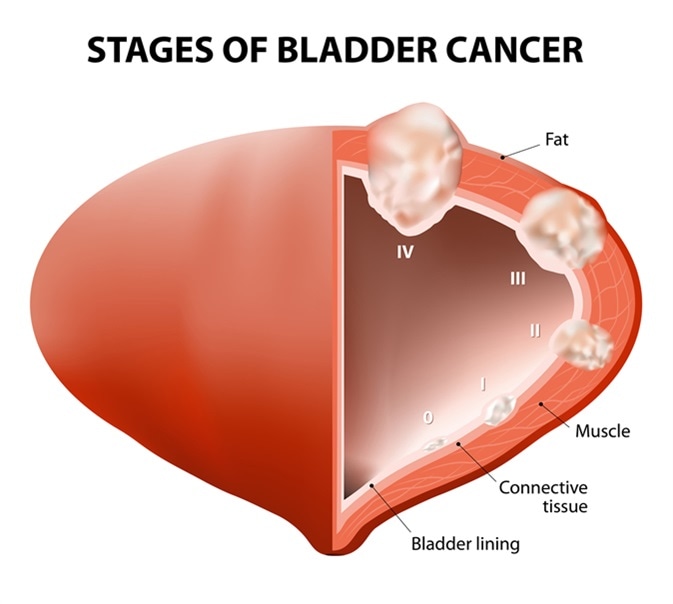There are many techniques which are used to diagnose and monitor bladder cancer, but the most common are highly invasive. These techniques cause anxiety for the patient and can impact how early the cancer can be detected. Since early diagnosis is key for boosting patient prognosis, several non-invasive techniques have been suggested as possible alternatives to these traditional methods.

Invasive Techniques
One example of an invasive diagnostic tool is using cystoscopy. This is very uncomfortable procedure, in which a thin camera within a tube is inserted through the urethra, allowing the doctor to observe the bladder and detect abnormal growths.
Upon the detection of a tumour through this method, a biopsy is often carried out, in which the tumor and surrounding tissue is removed and analysed. This can indicate both the staging of the cancer (dependent upon their differentiation) and the invasiveness of the tumor (dependent upon the level of invasion into the surrounding tissue). Overall, these methods are accurate and can inform doctors about numerous key qualities, but they are also very invasive and cause lots of psychological stress.
Imaging Techniques
Instead of viewing the tumour from inside the body or removing it, there are numerous less-invasive techniques which allow the tumour to be viewed from outside the body. These methods use either sound waves, x-rays or magnetic fields to create highly accurate and detailed images of internal structures, and can be used to identify growth abnormalities.
Firstly, a computed tomography (CT) scan can be carried out, which forms a 3-D image of the inside of the body using x-rays. More specifically, a CT scan involving the bladder is called a CT urogram. This technique can be used to detect changes in tissue structure and nearby lymph nodes, indicating the size and position of the tumour and the stage of the cancer.
Another type of non-invasive cancer imaging is magnetic resonance imaging (MRI). Instead of x-rays, magnetic fields are used to form images of internal structures and identify tumours.
Other imaging techniques are also often used to indicate if the bladder cancer has spread or not. These include chest x-rays, which can show if the cancer has spread to the lungs. Additionally, bone scans can be used to show if cancer has spread it the bone, using radioactive labelling.
Overall, imaging techniques are important methods in bladder cancer diagnosis, providing an alternative to invasive cystoscopies and biopsies.
Urine Analysis Techniques
Another non-invasive technique for detecting bladder cancer is through the analysis of urine samples. These samples can undergo numerous tests to detect possible tumours and monitor treatments. Initially they can be analysed under a microscope, a technique called urinary cytology, looking for the presence of cancerous cells. However, this test is not as accurate as other methods.
To enhance accuracy, urinary samples can also be tested for the presence of cancer-related biomarkers. These are molecules which are either formed by the cancer or due to the presence of the cancer. Therefore, detection of these markers within urine can indicate the presence of a tumor in the bladder.
For example, NMP22 and human complement factor H proteins are present at much higher levels in cancer patients than those without cancer. Therefore, highly specific and sensitive tests have been designed to detect these proteins at low levels. Additionally, mutations in DNA can also be detected, such as a point mutation in the fibroblast growth factor receptor 3, found in approximately 50% of bladder cancer patients.
Overall there are many different testing options for bladder cancer. The standard procedure for tumor detection is through the invasive techniques, such as cystoscopy and biopsies. However, these alternate methods also enable the detection of cancers without the associated psychological anxieties and unconformable procedures.
There are also many more biomarkers currently under investigation for applications within bladder cancer diagnosis, and may further enhance the effectiveness of non-invasive urine analysis.
Sources
- www.cancer.org/…/how-diagnosed.html
- www.cancer.org/…/detection.html
- https://www.nhs.uk/conditions/Cystoscopy/
- https://labtestsonline.org.uk/tests/tumour-markers
Further Reading
- All Bladder Cancer Content
- What is Bladder Cancer?
- What Causes Bladder Cancer?
- Bladder Cancer Diagnosis
- Bladder Cancer Treatment
Last Updated: Aug 23, 2018

Written by
Hannah Simmons
Hannah is a medical and life sciences writer with a Master of Science (M.Sc.) degree from Lancaster University, UK. Before becoming a writer, Hannah's research focussed on the discovery of biomarkers for Alzheimer's and Parkinson's disease. She also worked to further elucidate the biological pathways involved in these diseases. Outside of her work, Hannah enjoys swimming, taking her dog for a walk and travelling the world.
Source: Read Full Article
